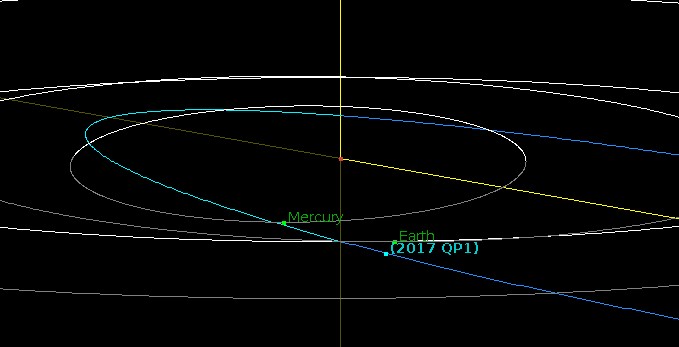Asteroid 2017 QP1 flew past Earth at 0.17 LD, 2 days before discovery

A newly discovered asteroid designated 2017 QP1 flew past Earth at a very close distance of 0.17 LD (~65 280 km / 40 563 miles) on August 14, 2017, two days before it was discovered. This is the 26th known near-Earth asteroid to flyby Earth within 1 lunar distance since the start of the year (according to data available September 20, 2017).
Asteroid 2017 QP1 was first observed at ATLAS-HKO, Haleakala on August 16, 2017, but it flew past Earth at around 21:23 UTC on August 14 at an estimated speed (relative to the Earth) of 23.97 km/s.
[ Ephemeris | Orbit Diagram | Orbital Elements | Physical Parameters | Close-Approach Data ]
This object belongs to the Apollo group of asteroids. It's estimated diameter is between 37 and 83 m (121 and 272 feet).
For comparison, the Chelyabinsk meteorite that exploded some 28.7 km (18.5 miles) above the Russian city of Chelyabinsk on February 15, 2013 had an estimated size of approximately 20 m (65 feet). This object survived our atmosphere and its pieces were later found.
If we take 2017 QP1's smallest estimated size of 27 m (121 feet) and the same entry angle and composition, if would produce similar effects to those seen in the video below.

Check your speakers. Loud asteroid explosion on video.
The 2013 Chelyabinsk meteorite damaged over 3 000 buildings and injured over 1 500 people (mostly by broken window glass).
2017 QP1 is the 22nd known near-Earth asteroid to flyby Earth within 1 lunar distance since the start of the year. The next known flyby within 1 LD will take place at 05:42 UTC on October 12, 2017. That object is called 2012 TC4.
However, we have one very important flyby before the one we know will take place on October 12. That's 3122 Florence, also known as 1981 ET3, one of the largest known asteroids. Florence will flyby at a distance of 18.38 LD (~7 million km / 4.4 million miles / 0.047 AU) at 12:06 UTC on September 1, 2017.
This object's estimated diameter is between 4 and 9 km (2.4 and 5.6 miles) and although many known asteroids have passed by closer than this one, all of them were smaller asteroids.
"Florence is the largest asteroid to pass this close to our planet since the first near-Earth asteroid was discovered over a century ago," according to Paul Chodas of Center for NEO Studies.
At magnitude +9 in late August, Florence will be a relatively easy target for experienced observers at sites with dark skies. It won't be visible to the unaided eye but will become visible in small telescopes by late August.
References:
Asteroid 2017 QP1 at Minor Planet Center; CNEOS
Featured image: 2017 QP1 position on August 19, 2017. Credit: NASA/JPL (CNEOS)

Commenting rules and guidelines
We value the thoughts and opinions of our readers and welcome healthy discussions on our website. In order to maintain a respectful and positive community, we ask that all commenters follow these rules.